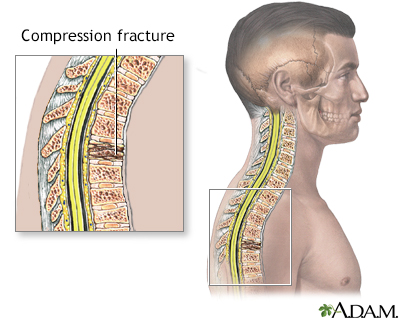Pregnancy SmartSiteTM
Vertebral compression fractures; Osteoporosis - compression fracture DefinitionCompression fractures of the back are broken vertebrae. Vertebrae are the bones of the spine. CausesOsteoporosis is the most common cause of this type of fracture. Osteoporosis is a disease in which bones become fragile. In most cases, bone loses calcium and other minerals with age. Other causes of compression fractures may include:
Having many fractures of the vertebrae can lead to kyphosis. This is a hump-like curvature of the spine. SymptomsCompression fractures can occur suddenly. This can cause severe back pain.
Compression fractures due to osteoporosis may cause no symptoms at first. Often, they are discovered when x-rays of the spine are done for other reasons. Over time, the following symptoms may occur:
Pressure on the spinal cord from hunched over posture can, in rare cases, cause: Exams and TestsYour health care provider will perform a physical exam. This may show:
A spine x-ray may show at least 1 compressed vertebra that is shorter than the other vertebrae. Other tests that may be done include:
TreatmentMost compression fractures are seen in older people with osteoporosis. These fractures often do not cause injury to the spinal cord. The condition is usually treated with medicines and calcium supplements to prevent further fractures. Pain may be treated with:
Other treatments may include:
Surgery may be done if you have severe and disabling pain for more than 2 months that does not get better with other treatments. Surgery can include: Other surgery may be done to remove bone if the fracture is due to a tumor. After surgery you may need:
Outlook (Prognosis)Most compression fractures due to injury heal in 8 to 10 weeks with rest, wearing of a brace, and pain medicines. However, recovery can take much longer if surgery was done. You will lose some height and have a more bent back. Fractures due to osteoporosis often become less painful with rest and pain medicines. Some fractures, though, can lead to long-term (chronic) pain and disability. Medicines to treat osteoporosis can help prevent future fractures. However, medicines cannot reverse damage that has already occurred. For compression fractures caused by tumors, the outcome depends on the type of tumor involved. Tumors that involve the spine include:
Possible ComplicationsComplications may include:
When to Contact a Medical ProfessionalContact your provider if:
PreventionTaking steps to prevent and treat osteoporosis is the most effective way to prevent compression or insufficiency fractures. Getting regular load-bearing exercise (such as walking) can help you avoid bone loss. Women should have their bone density checked at age 65, or earlier if you are at increased risk for osteoporosis. ReferencesAbode-Iyamah K. Compression fracture with back pain. In: Chaichana KL, Quiñones-Hinojosa A, eds. Comparative Management of Spine Pathology. Philadelphia. PA: Elsevier; 2021:chap 24. LeBoff MS, Greenspan SL, Insogna KL, et al. The clinician's guide to prevention and treatment of osteoporosis. Osteoporos Int. 2022;33(10):2049-2102. PMID: 35478046 pubmed.ncbi.nlm.nih.gov/35478046/. Savage JW, Anderson PA. Osteoporotic spinal fractures. In: Browner BD, Jupiter JB, Krettek C, Anderson PA, eds. Skeletal Trauma: Basic Science, Management, and Reconstruction. 6th ed. Philadelphia, PA: Elsevier; 2020:chap 35. Waldman SD. Thoracic vertebral compression fracture. In: Waldman SD, ed. Atlas of Common Pain Syndromes. 4th ed. Philadelphia, PA: Elsevier; 2019:chap 73. Williams KD. Fractures, dislocations, and fracture-dislocations of the spine. In: Azar FM, Beaty JH, eds. Campbell's Operative Orthopaedics. 14th ed. Philadelphia, PA: Elsevier; 2021:chap 41. | ||
| ||
Review Date: 8/12/2023 Reviewed By: C. Benjamin Ma, MD, Professor, Chief, Sports Medicine and Shoulder Service, UCSF Department of Orthopaedic Surgery, San Francisco, CA. Also reviewed by David C. Dugdale, MD, Medical Director, Brenda Conaway, Editorial Director, and the A.D.A.M. Editorial team. View References The information provided herein should not be used during any medical emergency or for the diagnosis or treatment of any medical condition. A licensed medical professional should be consulted for diagnosis and treatment of any and all medical conditions. Links to other sites are provided for information only -- they do not constitute endorsements of those other sites. No warranty of any kind, either expressed or implied, is made as to the accuracy, reliability, timeliness, or correctness of any translations made by a third-party service of the information provided herein into any other language. © 1997- A.D.A.M., a business unit of Ebix, Inc. Any duplication or distribution of the information contained herein is strictly prohibited. | ||


 Compression fractu...
Compression fractu...
